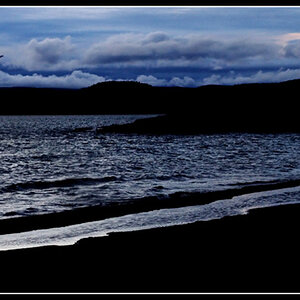- Joined
- Sep 2, 2005
- Messages
- 14,455
- Reaction score
- 3,328
- Can others edit my Photos
- Photos OK to edit
I've been meaning to do this for a while. I've had to explain depth of field and aperture so many times, I had figured maybe I should draw up a little diagram so I could show it to people when the question was asked.
Please let me know what you think- is this a good way to demonstrate it? Did I cover it correctly? Did I miss anything?

Note that these are conceptual examples only. They are by no means literal or to scale. The intention is to give one the idea of how this works, not to necessarily show specific effects.
In each diagram above we have an X that represents the camera's sharpness of focus along a path extending out from the front of the lens towards the subjects. As the lines of the X become closer together, the subjects become more in focus. The cross-point of the X is where the camera has been focused on the specific subject in question, and where the camera is most in focus.
The depth of field is represented by the green coloring in the diagram on either side of the X cross over point. Where there is more green, the subject within that space in the scene is more in focus.
The yellow smily faces represent the subject we have focused on, while the gray smily faces represent subjects closer to, and further away from, the camera.
In a typical wide-angle situation (shown in Figure 1), the aperture (and therefore the X) is very wide (smaller number f-stop), and so the object being focused on is really the only thing that will truly be in focus, and all objects closer to the camera or further away than the subject are out of focus. This means you have a very shallow depth of field. This can be desirable if you want the non-subject items in the frame to be fuzzier, as you may choose to do in a portrait.
In the case where you need to maintain a wider aperture to allow more light into the camera, but you want to bring more items into focus, you may choose to step further away from your subject. This is exemplified by Figure 2. The aperature (and thus the X) is no less wide, but more items are more in focus. Note that by no means are the items before and beyond the subject completely in focus, but they are still more so. How in focus they are depends on how far away you get from the subject, how wide the aperature is, etc.
In the case where you can afford to lose some of your light and still expose the scene properly, you have the option to narrow your aperture (larger number f-stop) to bring more items into focus. This is illustrated in Figure 3. Here we have narrowed the aperature (and thus the X). This brings the lines of the X closer together, thus increasing the depth of field and bringing subjects closer to, and further away from, the camera more into focus. A common example of when you might do this would be in a landscape picture where you want as much of the scene in focus as possible.
It is important to understand that in most circumstances, the only thing that is truly in focus is at the cross point on the X, and all other things are at least slightly out of focus. This may be a nearly unnoticable variation in the case of much smaller aperatures.
Please let me know what you think- is this a good way to demonstrate it? Did I cover it correctly? Did I miss anything?

Note that these are conceptual examples only. They are by no means literal or to scale. The intention is to give one the idea of how this works, not to necessarily show specific effects.
In each diagram above we have an X that represents the camera's sharpness of focus along a path extending out from the front of the lens towards the subjects. As the lines of the X become closer together, the subjects become more in focus. The cross-point of the X is where the camera has been focused on the specific subject in question, and where the camera is most in focus.
The depth of field is represented by the green coloring in the diagram on either side of the X cross over point. Where there is more green, the subject within that space in the scene is more in focus.
The yellow smily faces represent the subject we have focused on, while the gray smily faces represent subjects closer to, and further away from, the camera.
In a typical wide-angle situation (shown in Figure 1), the aperture (and therefore the X) is very wide (smaller number f-stop), and so the object being focused on is really the only thing that will truly be in focus, and all objects closer to the camera or further away than the subject are out of focus. This means you have a very shallow depth of field. This can be desirable if you want the non-subject items in the frame to be fuzzier, as you may choose to do in a portrait.
In the case where you need to maintain a wider aperture to allow more light into the camera, but you want to bring more items into focus, you may choose to step further away from your subject. This is exemplified by Figure 2. The aperature (and thus the X) is no less wide, but more items are more in focus. Note that by no means are the items before and beyond the subject completely in focus, but they are still more so. How in focus they are depends on how far away you get from the subject, how wide the aperature is, etc.
In the case where you can afford to lose some of your light and still expose the scene properly, you have the option to narrow your aperture (larger number f-stop) to bring more items into focus. This is illustrated in Figure 3. Here we have narrowed the aperature (and thus the X). This brings the lines of the X closer together, thus increasing the depth of field and bringing subjects closer to, and further away from, the camera more into focus. A common example of when you might do this would be in a landscape picture where you want as much of the scene in focus as possible.
It is important to understand that in most circumstances, the only thing that is truly in focus is at the cross point on the X, and all other things are at least slightly out of focus. This may be a nearly unnoticable variation in the case of much smaller aperatures.
Last edited:


 Holy cow, and I'm usually a reely goood sphellar.
Holy cow, and I'm usually a reely goood sphellar.![[No title]](/data/xfmg/thumbnail/37/37539-ae46a74e6510aad73c9101a029847880.jpg?1619738133)

![[No title]](/data/xfmg/thumbnail/37/37538-d4704bfd4f0e4b1941649d81ff8edf2c.jpg?1619738133)



![[No title]](/data/xfmg/thumbnail/33/33356-9cfc19255e84aab13c903f781a99cf9f.jpg?1619735920)

![[No title]](/data/xfmg/thumbnail/37/37605-90c8efaef5b7d1f52d4bf8e7dfd33673.jpg?1619738148)


